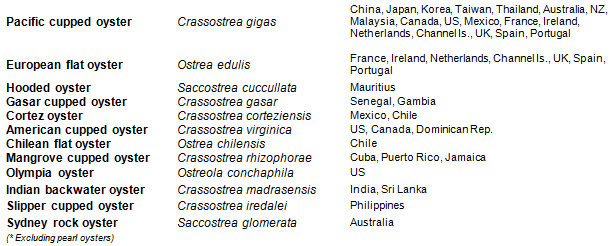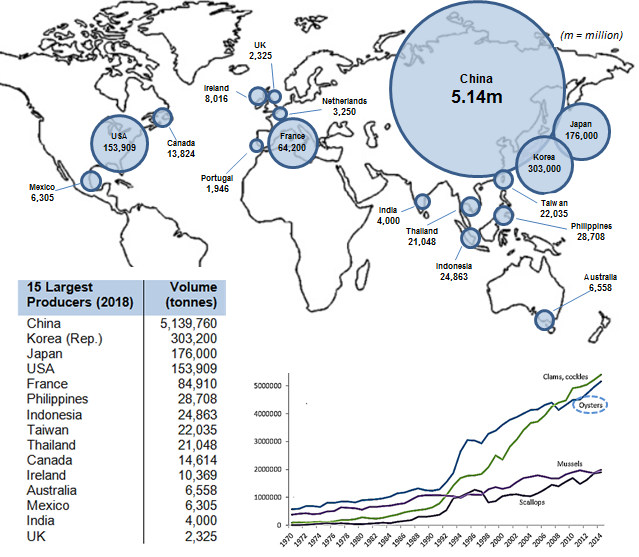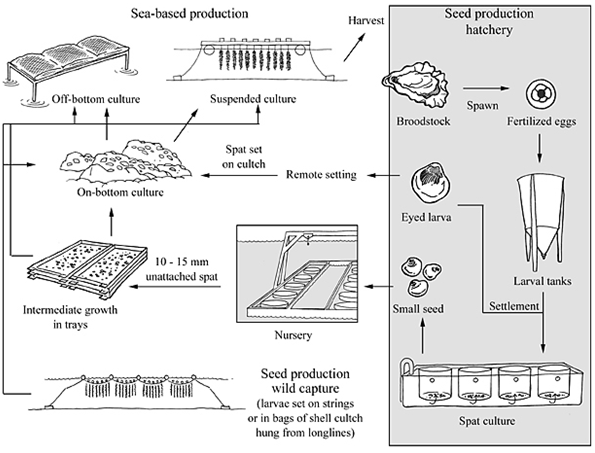Oysters
Various species
Sources, Quantities and Cultivation Methods
Across the world farmed oysters include over twelve different species (native and introduced)1 as shown in the table below. Oysters are bivalve molluscs and feed by filtering mainly microscopic algae (phytoplankton), but also some organic detritus from sea water. Oysters grow naturally on the seabed or by attaching to a hard substrate.
Most species of oyster used in aquaculture can be found naturally in marine and brackish areas close to the coast in shallow depths. Their ability to close their shells when environmental conditions are unfavourable allows them to survive when salinity drops or tidal levels leave them exposed. Their adaptability makes the oyster a good species for aquaculture. Oysters can be farmed in locations which are accessible at low tide which often makes expensive farming equipment or service vessels unnecessary.

There are two distinct types of oyster used in aquaculture; the ‘cupped’ oysters (Crassostrea/Saccostrea species) and the ‘flat’ oysters (Ostreacea):
- Cupped oyster species are genetically quite similar to each other and many geographically named oysters are the same species, e.g. the Sydney rock oyster and the New Zealand rock oyster are Saccostrea glomerata2; the Japanese/ Portuguese/Pacific oyster are Crassostrea gigas3. Cupped oysters form the bulk of global oyster production and Pacific oyster is the main farmed species1.
- Flat oysters have a much lower global production. Some species can be slower growing and less robust than the cupped oyster species, however they are often more highly prized gastronomically4.
Oysters are farmed across the globe. Aquaculture production of oysters has increased substantially since 1990; from 1.2 million tonnes to 6 million tonnes in 2018 with a value of US$7.46 billion. China accounts for around 85% of globally farmed oysters and consumes almost all of its own production1, 5.

Annually only around 50,000 tonnes of oysters are internationally traded. The majority of oyster exports originate from Korea, France and China. In the EU, France, Spain and Italy are the main importers of oysters, while France is also among the top exporting countries5.
Less than 5% of total world bivalve production enters international markets; one of the lowest proportions in seafood trade. This is due to the very nature of bivalves, which are highly perishable and potentially risky for human health if not properly handled. The relatively short shelf life of oysters is an impediment to large-scale global trade as consumer preference is often for live, half shell oysters or freshly shucked meats. Value-added and convenience products, including canned oysters and frozen or vacuum packed oysters prepared with various sauces, do appear and have potential for global distribution; however, they represent only a small proportion of total production5.
Domestic Market Information
Our domestic seafood market is complex mix of products from wild caught and farmed species, including oysters.
To discover more about the highly dynamic and ever-changing UK and Great British (GB) seafood marketplace, you can explore our user friendly and interactive Trade and Tariff in Tableau (T4) online tool. And visiting our dedicated Insight and Research pages will provide you with access to a wealth of information, from reports to factsheets on markets including:
- Retail – data from independent and multiple retailers in the UK used to reveal the latest insights on seafood eaten at home
- Foodservice – data from the foodservice industry in the UK used to highlight the latest trends on seafood eaten out of home
- Market supply – HM Revenue and Customs (HMRC) data used to detail what species and products are imported from, and exported to, the UK
To get the latest seafood market performance and trends delivered to your inbox, register at the Market Insight Portal.
Production Method
The Japanese have been cultivating Pacific oyster for centuries. The species has been introduced elsewhere, most significantly to the western seaboard of the US in the 1920s, France in 1966, and to the UK at various times in 1960’s and 70’s4, 6. The Pacific oyster has been introduced either to replace stocks of indigenous oysters severely depleted by over-fishing or disease, or to create an industry where none existed before7, 8, 9.
Introductions of the Pacific oysters, either intentionally or not (e.g. carried in ballast water or attached to ship hulls) have seen the development of small fisheries with the naturalisation of the species10. There are several incidences globally where introductions of new species of oyster for aquaculture are out competing native oyster species (e.g. Australia, UK, Netherlands and New Zealand)4, 11. Although perceived as a nuisance in some environments, it is also considered a valuable resource by others.
Oyster aquaculture includes a wide range of grow-out techniques in inter-tidal or sub-tidal waters: suspension of oysters in the water column via rafts, floats, racks or trestles, or bottom culture where oysters are grown directly on the seabed12, 13.

Wild oyster spat (seed) can be collected where it is abundant and reliable. A common method is to use ‘cultch’ (e.g. oyster shells) to act as a surface for the oyster larvae to settle on. When they have grown to a few millimetres, they are removed from the collectors and are ready for on-growing. Much of the global supply of Pacific oyster seed is obtained from wild seed capture12.
European oyster production however is commonly derived from hatchery-reared seed. Oyster broodstock is maintained in marine facilities, where their fertilised eggs are developed to larvae in large tanks filled with filtered (and often UV-treated) seawater, and fed cultured algae. Generally the larvae will be encouraged to settle and then grown until they are large enough to be transferred for on-growing.
On-growing of oysters is almost entirely sea-based; the type of rearing method depends on both the environment (tidal range, water depth, etc.) and tradition. No feed is supplied and no chemicals or medicines are administered.
In Europe, along France’s Atlantic coastline for instance, oysters are mainly produced by ‘off-bottom culture’, i.e. placed in plastic mesh bags attached to trestles or in rigid, perforated containers. ‘Suspended culture’ is where oysters are reared on ropes; a technique suitable for rearing in sheltered waters. Countries such as Spain use this technique.
Growth of farmed oysters varies depending on temperature and natural food supplies, but Pacific oysters will take 18-30 months to reach a market size of 70-100 g live weight (shell-on).
References
- FAO FishStatJ
- Maguire, G.B. and Nell, J.A., 2001. History, Status and Future of Oyster Culture in Australia. Oyster Research Institute News No.19
- Menzel, RW., 1974. Portuguese and Japanese oysters are the same species. Journal of the Fisheries Research Board of Canada 31 p453-456.
- Spencer, B.E. 2002. Molluscan Shellfish Farming. Fishing News Books, Blackwell Publishing, 274 pp
- GLOBEFISH
- FAO
- Shatkin, G., Shumway, S.E. and Hawes R., 1997. Considerations regarding the possible introduction of the Pacific oyster (Crassostrea gigas) to the Gulf of Maine: a review of global experience. Journal of Shellfish Research 16 (2) p463-477
- Utting, S.D., and Spencer, B.E. 1992. Introductions of bivalve molluscs into the United Kingdom for commercial culture - case histories. ICES Marine Science Symposium, 194 p84-91
- Nell, J.A., 2001. The history of oyster farming in Australia. Marine Fisheries Review, 63(3): 14-25
- Leffler, M. and Greer, J.R. 1991. The Ecology of Crassostrea gigas in Australia, New Zealand, France and Washington. Maryland Sea Grant, College Park, Maryland. UM-SG-TS-92-07
- Miossec, L., Le Deuff R.M. and Goulletquer, P., 2009. Alien species alert: Crassostrea gigas (Pacific oyster). ICES Cooperative Research Report, 299. Open Access version
- FAO
- Seafood Watch